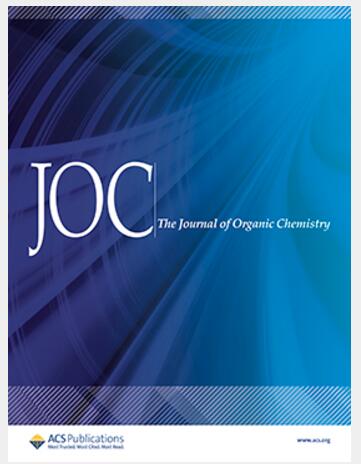Investigation into the Stereoelectronics of the Thiol-Promoted Fragmentation of Ylidenenorbornadienes (YNDs).
IF 3.6
2区 化学
Q1 CHEMISTRY, ORGANIC
引用次数: 0
Abstract
A simplified synthesis of 6,6-diaryl-substituted fulvenes from substituted benzophenones is reported, providing excellent yields for all substrates except those with strong electron-donating substituents. Symmetric diaryl-ylidenenorbornadienes (YNDs) were prepared via the reaction between 6,6-diaryl-substituted fulvenes and dimethyl acetylenedicarboxylate (DMAD). These YNDs were then reacted with propanethiol (PT) to afford four isolable diastereomers of YND-PT adducts, with trends in diastereomer ratios being attributed to the directing capabilities of aryl substituents during thiolate addition and protonation steps. Linear-free energy correlations were obtained for the retro-[4 + 2] fragmentation of substituted diaryl-YND-PTs. Electron-donating groups on the phenyl substituents on the ylidene of YNDs increased fragmentation rates. The half-lives of fragmentation typically increased by approximately 10-fold from the most electron-donating substituent (NMe2) to the most electron-withdrawing (NO2). The individual diastereomers were observed to fragment at markedly different rates. In one substrate, the fastest diastereomer fragmented 100 times faster than the slowest. A series of thiophenols (TPs) were used as the nucleophiles with a model YND system and provided a separable mixture of three diastereomers of YND-TP adducts. Linear-free energy correlations were obtained for the retro-[4 + 2] fragmentation of YND-TPs. Electron-withdrawing substituents on thiophenyl ethers were observed to increase the fragmentation rates of all diastereomers.巯基促进壬基二烯断裂的立体电子学研究。
本文报道了一种由取代二苯甲酮简化合成6,6-二芳基取代氟烯的方法,除具有强给电子取代基的底物外,所有底物的产率都很好。以6,6-二芳基取代的黄烯与二甲基乙炔二羧酸酯(DMAD)为原料,合成了对称的二芳基基苄基enorbornadiene (YNDs)。然后将这些ynd与丙硫醇(PT)反应得到四种可分离的YND-PT加合物的非对映体,其非对映体比率的变化趋势归因于芳基取代基在硫代酸加成和质子化步骤中的定向能力。取代的二芳基- ynd - pts的反向[4 + 2]断裂获得了线性无能量相关性。苯基取代基上的给电子基团增加了YNDs的断裂速率。从给电子最多的取代基(NMe2)到吸电子最多的取代基(NO2),断裂的半衰期通常增加约10倍。观察到不同的非对映体以明显不同的速率破碎。在一个衬底中,最快的非对映体比最慢的快100倍。以一系列噻吩(TPs)为亲核试剂,建立了YND- tp加合物的三种非对映体的可分离混合物。YND-TPs的反向[4 + 2]破碎得到了线性无能量相关性。噻吩醚上的吸电子取代基增加了所有非对映体的断裂速率。
本文章由计算机程序翻译,如有差异,请以英文原文为准。
求助全文
约1分钟内获得全文
求助全文
来源期刊

Journal of Organic Chemistry
化学-有机化学
CiteScore
6.20
自引率
11.10%
发文量
1467
审稿时长
2 months
期刊介绍:
Journal of Organic Chemistry welcomes original contributions of fundamental research in all branches of the theory and practice of organic chemistry. In selecting manuscripts for publication, the editors place emphasis on the quality and novelty of the work, as well as the breadth of interest to the organic chemistry community.
 求助内容:
求助内容: 应助结果提醒方式:
应助结果提醒方式:


